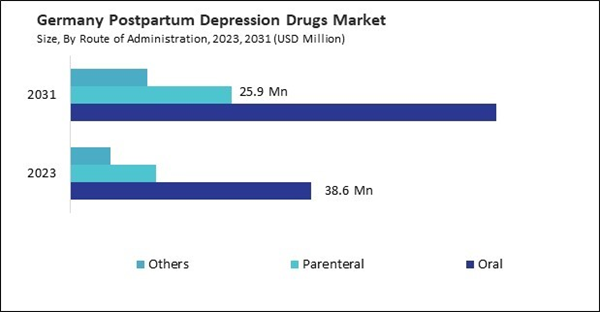The Germany market dominated the Europe Postpartum Depression Drugs Market by Country in 2023, and would continue to be a dominant market till 2031; thereby, achieving a market value of $106.8 million by 2031. The UK market is exhibiting a CAGR of 8.3% during (2024 - 2031). Additionally, The France market would experience a CAGR of 10.1% during (2024 - 2031).
Postpartum depression drugs are also effective in managing symptoms of anxiety that often accompany postpartum depression. These symptoms may include excessive worry, restlessness, irritability, and physical manifestations such as palpitations or muscle tension. Antidepressants with anxiolytic properties, such as selective serotonin reuptake inhibitors (SSRIs) and serotonin-norepinephrine reuptake inhibitors (SNRIs), are commonly prescribed to address both depressive and anxiety symptoms.
In some cases, these drugs may be used preventatively for women at high risk of developing PPD. Factors that may increase the risk include a history of depression or anxiety, hormonal fluctuations, stressful life events, or inadequate social support. Starting medication early, especially for women with a history of PPD, can help mitigate the onset or severity of symptoms.
The expansion of telemedicine in Italy enhances access to mental health services, including consultations for postpartum depression. Remote consultations and digital platforms facilitate easier access for patients in remote or underserved areas, increasing awareness and treatment-seeking behaviors. Also, increased investment in healthcare stimulates research and development initiatives focused on advancing postpartum depression drugs. Collaborations between Italian pharmaceutical companies and research institutions lead to the innovation of new treatment options tailored to local patient needs. Hence, the increasing healthcare sector is driving the market's growth.
Based on Treatment, the market is segmented into Pharmacotherapy, Hormonal Therapy, and Others. Based on Route of Administration, the market is segmented into Oral, Parenteral, and Others. Based on Distribution Channel, the market is segmented into Hospital Pharmacy, Retail Pharmacy, and Online Pharmacy. Based on Type, the market is segmented into Postpartum Anxiety, Postpartum Blues, Postpartum Obsessive-Compulsive Disorder (OCD), Postpartum Panic Disorder, Postpartum Post-Traumatic Stress Disorder (PTSD), and Postpartum Psychosis. Based on countries, the market is segmented into Germany, UK, France, Russia, Spain, Italy, and Rest of Europe.
List of Key Companies Profiled
- Pfizer, Inc.
- Eli Lilly And Company
- Novartis AG
- GlaxoSmithKline PLC (GSK)
- Merck & Co., Inc.
- Biogen, Inc.
- Teva Pharmaceutical Industries Ltd.
- Bausch Health Companies, Inc.(DermTech, Inc.)
- Cipla Limited
- Sage Therapeutics, Inc.
Market Report Segmentation
By Treatment- Pharmacotherapy
- Hormonal Therapy
- Others
- Oral
- Parenteral
- Others
- Hospital Pharmacy
- Retail Pharmacy
- Online Pharmacy
- Postpartum Anxiety
- Postpartum Blues
- Postpartum Obsessive-Compulsive Disorder (OCD)
- Postpartum Panic Disorder
- Postpartum Post-Traumatic Stress Disorder (PTSD)
- Postpartum Psychosis
- Germany
- UK
- France
- Russia
- Spain
- Italy
- Rest of Europe
Table of Contents
Companies Mentioned
- Pfizer, Inc.
- Eli Lilly And Company
- Novartis AG
- GlaxoSmithKline PLC (GSK)
- Merck & Co., Inc.
- Biogen, Inc.
- Teva Pharmaceutical Industries Ltd.
- Bausch Health Companies, Inc.(DermTech, Inc.)
- Cipla Limited
- Sage Therapeutics, Inc.
Methodology

LOADING...









